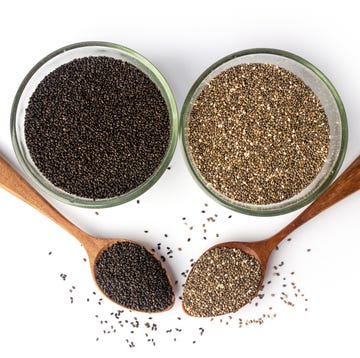- GLP-1 is a hormone that regulates blood sugar, appetite and digestion.
- A diet rich in high-fiber foods may help your body naturally release more GLP-1.
- Both moderate and high-intensity exercise may increase GLP-1 levels, but more research is needed.
It seems like everyone is talking about GLP-1 these days. And when you hear about it, you may assume that it's just associated with medications like Ozempic. But did you know that GLP-1 is actually a hormone, and one that your body already makes on its own? It plays a role in everything from appetite regulation to blood sugar control. Here's everything you need to know about GLP-1, including how it responds to the foods you eat.
What is GLP-1?
Short for glucagon-like peptide-1, GLP-1 is a naturally-occurring hormone in the body that plays a critical role in regulating blood sugar, appetite and digestion, according to registered dietitian and Wall Street Journal best-selling cookbook author Toby Amidor, MS, RD, CDN, FAND. "It belongs to a group of hormones called incretins, which help lower blood glucose levels. GLP-1 is produced in the small intestine and released after a meal."
The hormone is made specifically in your gut and helps to not only naturally regulate appetite but also blood sugar. "The GLP-1 hormone helps keep you full longer by slowing how quickly food leaves your stomach," says Denisse Colindres, MSc, Senior Manager of Nutrition Communication at the BENEO-Institute. "It also signals your brain to eat less. This combination helps people naturally reduce how much they eat without feeling as hungry."
GLP-1 medications, also known as GLP-1 receptor agonists, mimic this hormone to help treat type 2 diabetes and obesity, says Lauren Harris-Pincus, MS, RDN, founder of NutritionStarringYOU.com and author of The Everything Easy Pre-Diabetes Cookbook. "GLP-1 medications assist with blood sugar regulation by increasing insulin secretion when blood sugar is high and decreasing glucagon secretion (which raises blood sugar). They help with appetite control by slow down stomach emptying, making people feel fuller longer."
How does diet impact GLP-1?
In short, consuming a diet rich in nutritious, high-fiber foods can help your body naturally release more GLP-1, with or without medication. "Foods high in non-digestible carbohydrates and fermentable fibers help to increase the production of short-chain fatty acids in the gut, which in turn increase natural GLP-1 production. That’s a fancy way of emphasizing the importance of fiber in our diets," Harris-Pincus says, adding that about 93% of Americans don't meet the recommended 25 to 38 grams of fiber per day.
"Certain foods create a greater GLP-1 release than others, especially those that take a long time to digest," notes registered dietitian and diabetes educator Caroline Thomason, RD, LDN, CDCES. "Prebiotic fiber feeds the good bacteria in your gut, which can help your body produce GLP-1 during digestion. As the good bacteria ferment the fiber, they produce short-chain fatty acids (SCFAs), which in turn signals your body to release more GLP-1." She adds that this process supports appetite regulation, gut health, and metabolism — all naturally from increasing high prebiotic fiber foods. Some examples include legumes like chickpeas and lentils, asparagus, Jerusalem artichokes and bananas.
But other nutrients play important roles, too. "Protein and healthy fats naturally boost GLP-1, particularly more than refined, quick digesting carbs. But high fiber carbohydrates, fat, and prebiotics fiber have the greatest impact on increasing GLP-1." Thomason adds. Some research suggests that unsaturated long-chain fatty acids (like those found in olive oil) can increase how much GLP-1 is released, according to Amidor. "ALA and DHA PUFAs [polyunsaturated fatty acids] found in flaxseed oil and fish have also been shown to increase GLP-1 and decrease blood sugar."
But interestingly enough, Amidor points out that studies have shown a change or imbalance in the diversity, composition and functions of the microbiota to reduced GLP-1 levels. "Reduced GLP-1 levels are directly associated with development of metabolic disorders, including type 2 diabetes and obesity." Although the research on how diet impacts GLP-1 is still early and mostly based on animal studies and limited human data, the experts agree that these eating habits are still great for overall health and weight management.
Does exercise increase GLP-1 levels?
"Exercise can positively impact GLP-1 levels and its effects, contributing to better blood sugar control, weight management, and overall health," Amidor says, citing literature published in Endocrinology, Diabetes and Metabolism that suggests exercise can increase GLP-1 levels for 24 hours.
Some research shows that moderate and high-intensity exercise can increase GLP-1 levels, too. "This can make your body more sensitive to it, helping you feel fuller and stabilize your blood sugar even better," Thomason adds. Overall, there are only a few studies that have examined the association between exercise and GLP-1 secretion, so Harris-Pincus says that more research is needed.
The bottom line
Plant-forward diets like Mediterranean, DASH, and the MIND diet are focused on fiber-rich foods that can help to support natural GLP-1 production, Harris-Pincus says. "It’s not a secret that eating a diet rich in fruit, veggies, beans, legumes, nuts, seeds, and whole grains help to reduce the risk of lifestyle diseases including heart disease, diabetes, and cancer." While GLP-1 production is a small piece of that, she adds that these diets also meet micronutrient needs plus antioxidants and phytonutrients that aid in reducing systemic inflammation.
And ultimately, there isn't one single magical food to eat, but rather how your eating patterns on the whole support your metabolic health, Thomason says. "Choosing foods rich in prebiotic fiber is a great starting place. Focusing on eating 10 grams of prebiotic fiber per day has been shown to have a significant impact on GLP-1 and weight loss as a result." Remember that as you start to increase the fiber in your diet, do so slowly and drink plenty of water to help the fiber properly digest.
Dr. Deena Adimoolam, known by many of her patients as "Dr. Deena", received her medical degree and training at the Icahn School of Medicine at Mount Sinai. She then completed her residency training in primary care/internal medicine and subsequent fellowship in endocrinology, diabetes and metabolism at Yale University.
After her many years at Yale, she returned back to Mount Sinai as an Assistant Professor of Medicine and Associate Program Director of the endocrinology fellowship program.
Dr. Adimoolam has published research and written chapters for major textbooks in the areas of diabetes and obesity.
She is passionate for educating the public on disease prevention and hormone health, and uses various media outlets to do so. She serves as a media expert and has worked with most major news organizations in print, online, and television.
She works closely as a spokeswoman for the Endocrine Society - the largest medical organization in the field of endocrinology and metabolism and is very active with other local and national health organizations.














